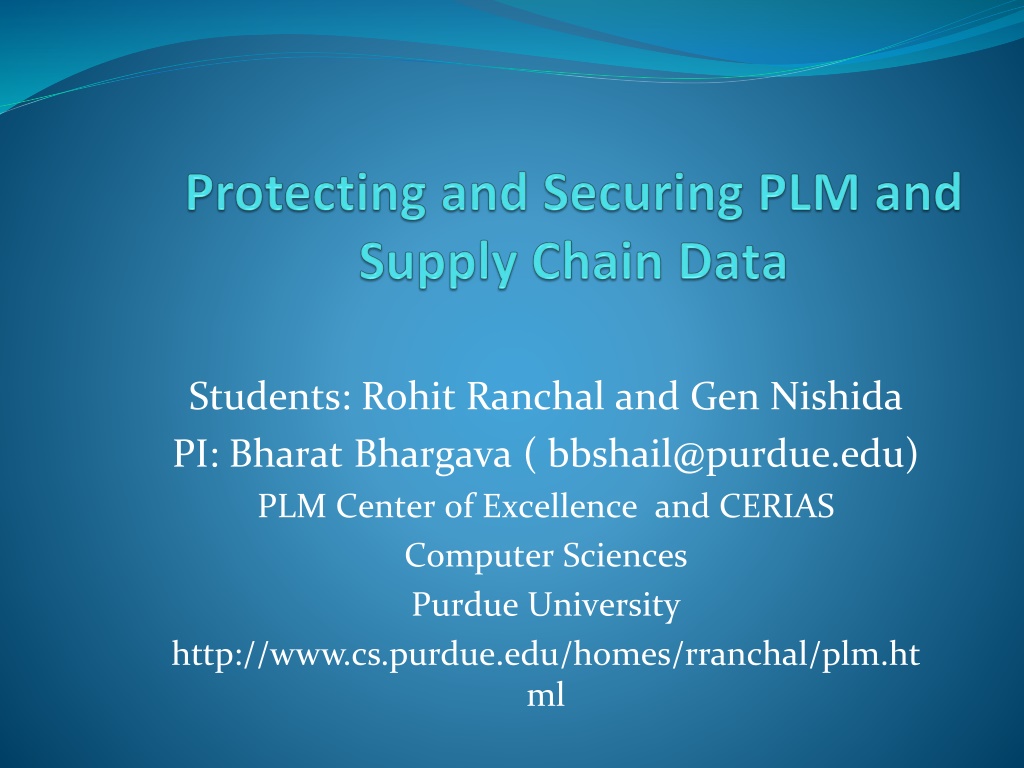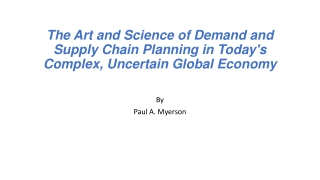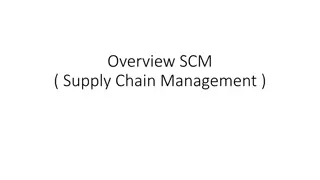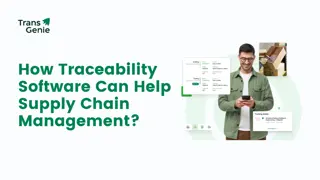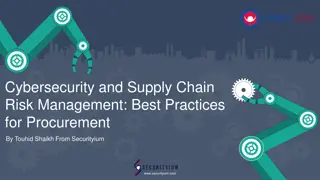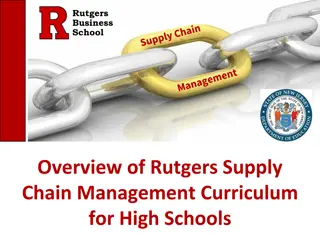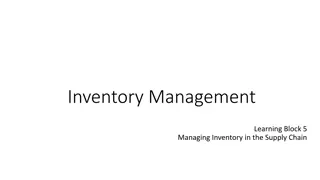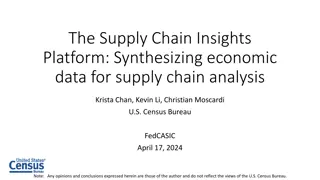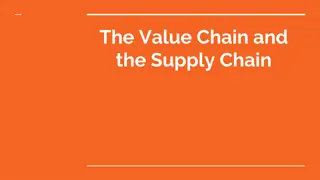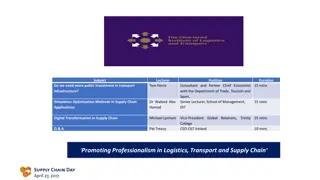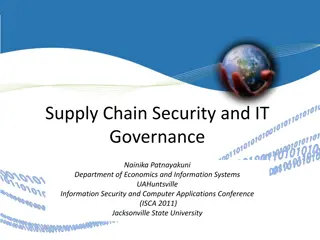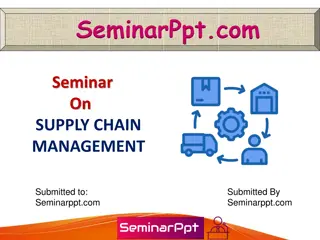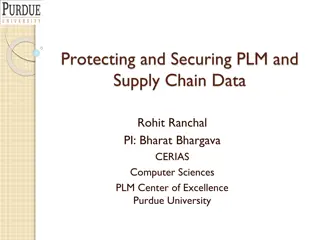Enhancing Security in Global Supply Chain Information Flow
This project, led by Bharat Bhargava at Purdue University, focuses on safeguarding information flow in globally distributed supply chains. They propose security measures such as Active Bundle Scheme and End-to-End Auditing to address challenges. Accomplishments include publications and prototypes. The study is motivated by the need to protect sensitive data shared within supply chains involving companies like Boeing and Cummins.
Download Presentation

Please find below an Image/Link to download the presentation.
The content on the website is provided AS IS for your information and personal use only. It may not be sold, licensed, or shared on other websites without obtaining consent from the author.If you encounter any issues during the download, it is possible that the publisher has removed the file from their server.
You are allowed to download the files provided on this website for personal or commercial use, subject to the condition that they are used lawfully. All files are the property of their respective owners.
The content on the website is provided AS IS for your information and personal use only. It may not be sold, licensed, or shared on other websites without obtaining consent from the author.
E N D
Presentation Transcript
Students: Rohit Ranchal and Gen Nishida PI: Bharat Bhargava ( bbshail@purdue.edu) PLM Center of Excellence and CERIAS Computer Sciences Purdue University http://www.cs.purdue.edu/homes/rranchal/plm.ht ml
Outline Project Summary Motivation Background Problem: Information Flow in Supply Chain Impacts and Challenges Related Work Proposed Approach for Security in Supply chain Approach 1: Active Bundle Scheme Approach 2: End to End Auditing Future Plans Privacy Preserving Identity Exchange 2
Project Summary/Accomplishments Proposal Protecting and Securing Supply Chain Data throughout its Lifecycle Publications (http://www.cs.purdue.edu/homes/rranchal/plm.html) Protecting PLM Data throughout their lifecycle (Qshine 2013) Secure Information Sharing in Digital Supply Chains (IEEE IACC 2013) Poster in CERIAS annual symposium Prototype Active Bundle prototype based on Mobile Agents Active Bundle prototype based on JAR file Active Bundle prototype improvements using Key splitting and Distributed Hash Tables End to End Security software Proposal submitted to ABB on Information Sharing Security and Visibility in Supply Chain Collaboration Proposal in progress for submission to NSF 3
Boeing Supply Chain for Motivation 4
Globally distributed operations e.g. Boeing, Cummins, Background: Modern Enterprises Dow Agro Sciences, Rolls-Royce, GM Focus on core competencies and outsource auxiliary tasks to partner organizations Rely on Supply Chain to collaborate with partners in transforming raw materials into products Use PLM Information Systems to manage the information flow that facilitates the movement of physical product related entities in the supply chain PLM systems continuously receive, process and share dynamic supply chain information (sensitive data) Commercial information shared with advisors and lawyers Personally identifiable information about customers and employees Intellectual property shared with partners 5
Background: Supply Chain Interaction Information Flow in Supply Chain 6
Information Flow in Supply Chain Globally distributed supply chain processes Information not confined to a single domain but distributed among and controlled by multiple partners Outsourcing of shared information by partner organizations No way to track the information access and usage in external domain (organization has no control over the processes in external domain) Intermediate steps of information flow might expose information to hostile threats Unauthorized disclosure and data leakage of information shared among partners across multiple domains Violations and malicious activities in a trusted domain remain undetected 7
Impact of Security Threats Leakage of sensitive information - list of customers, product design secrets, pricing, etc. to competitors, malicious entities, government institutions or attackers High financial and losses Damage to the reputation of organization and its partners Criminal activities leading to delay in manufacturing and delivery Impact on National Security 8
Challenges for Supply Chain Security Lack of mechanisms to communicate information owner s policies to the protection frameworks of the partners Lack of information sharing standards for protecting data in distributed supply chains Custom security requirements and controls applied by partners Incompatibility and reduced ability to ensure policy enforcement leaves security gaps Disparate, evolving and changing Information security standards to satisfy changing business models, regulatory and geographical law requirements 9
Related Work Generalized approach to protect shared data Secure data e.g. using encryption Define Policies for data sharing and usage e.g. access control policies Setup Policy enforcement mechanism to enforce policies on data Classification of available solutions Policy Enforcement at the Sender Policy Enforcement in the middle Policy Enforcement at the Receiver 10
Policy enforcement at owner Traditional approach uses Related Work encryption for protection (interactive protocols) e.g. Servers A lot of exchange of messages Source can become bottleneck Problem if source becomes unavailable Digibox [5] uses multiple keys 11
Related Work Trusted Third Party e.g. pub/sub Policy enforcement in the middle Single point of trust and failure Information aggregation - caches and stores data Can sell data to interested parties Data disclosure during Subpoenas Prone to hacking attacks and insider abuse Casassa Mont et al [9] uses time vault service 12
Policy enforcement at receiver Requires a Trusted component Related Work Eg Digital Rights Management solutions, Document-sharing solutions - Adobe, Microsoft etc Distribution issues of Trusted component Restricted to known/trusted hosts Montero et al [6] uses sticky policies 13
Proposed Approach Existing approaches that rely on the use of standards, service level agreements, and legal contracts are insufficient Propose an end-to-end approach for protecting shared data in digital supply chains Self-protecting data centric approach for policy based controlled data dissemination Security auditing of business processes that compose supply chains Enables tracking the information flows of shared data Detecting malicious interactions and compromised business processes of partners Tracks the data flow and actions upon them and enables auditing, detecting and reporting policy violations 14
Active bundle (AB) [12, 13] Encapsulation mechanism for Approach 1: Self-Protecting Data protecting data Includes metadata for controlled dissemination Includes Virtual Machine Policy enforcement mechanism Protection mechanism Active Bundle Operations Self-Integrity check Filtering Selective dissemination based on policies Apoptosis Self-destructs AB completely 15
What is Active Bundle An active bundle is a container with a payload of sensitive data, metadata (including, among others, privacy policies), and a virtual machine (VM) specific to the active bundle. We show that data, encapsulated within active bundles can protect their own confidentiality. ABs protect privacy of of sensitive data through: (i) assuring enforcement of data privacy policy by the VM from the active bundle that includes the data; (ii) relying on host trustworthiness to activate protection mechanisms when data are tampered with; and (iii) recording all data-related activities by the VM. AB scheme ensures (1) encrypting sensitive data and storing decryption keys at a TTP; (2) signing data to ensure their integrity; (3) activating apoptosis when a host receiving the bundle is not allowed to access any portion of active bundle s data due to its sufficient trust level; (4) decrypting data, checking integrity of data and simulating enforcement of privacy policies when the receiving host is allowed to access a portion or all data; (5) collecting audit information and storing it by the Audit Service Agent on a TTP.
AB Implementation AB based on Mobile Agent Framework Jade AB sent as a Mobile Agent Mobile Agent is a software object able to perform computations on visited hosts, transport itself from one host to another, and interact with and use capabilities of visited hosts Java sensitive data, metadata for policies and code for the VM of active bundle Trusted Third Party for crypto keys, trust and audit AB based on a JAR file AB sent as a JAR file Java archive (JAR) file represents the nested structure of active bundles. Java code as VM of the active bundle Privacy policy file as Metadata Sensitive data as a document (PDF file) 17
AB based on TTP [13] AB information disclosure Active Bundle Destination User Application Active Bundle Active Bundle (AB) Active Bundle Creator Audit Services Agent (ASA) Security Services Agent (SSA) Directory Facilitator Trust Evaluation Agent (TEA) Active Bundle Coordinator Active Bundle Services 19
Enabling AB 20
AB Formal Access Control Model ? set of subjects, ? set of rights (read, append, own) ?? set of active bundles ? access control list (set of pairs) ? = ?????? a function that represents the privacy policy associated with a particular active bundle ?? ?,? :? ?,? ? ??,??:1 ? ? ?????? ?? = means ?? is allowed to access ?? using any right in ??. 21
AB Updates Supply Chain entities in the information flow receive AB and update its information Scenario 1: Send update request to owner Distributor Retailer Sensitive data Information addition Sensitive data 22
Problems with updating an AB Advantage Simple The owner can control every update Disadvantage The update request may be rejected or partially rejected by the owner The new privacy policy for the updated AB is created by the owner which may conflict with the updater s policy The updater may not want the original owner to know the appended data The owner may get a lot of requests for updates 23
AB Update Solution Nested Structure An active bundle autonomously grows into a bigger active bundle including both the original active bundle and the appended information with new metadata and virtual machine ??? ?,? ?,? Sensitive data ?,? Appended information Sensitive data ??? ??? ??? ??? ??? ??? 24
Experiments File Size 35 30 25 [MB] 20 15 File Size [MB] 10 5 0 0 1 2 3 4 5 6 7 8 9 10 Updates Creation Time 14 12 10 8 [sec] 6 Average Creation Time [s] 4 2 0 1 2 3 4 5 6 7 8 9 10 Updates 25
AB Update Solution Advantage Any entity with the permission to append information can append and specify the new privacy policy for the appended information Existing policies are still effective on the existing data and new policies are only enforced on the appended data and the existing data The nested structure of an active bundle naturally represents the history of updates Disadvantage AB s size grows linearly with every update The new policies may be more restrictive than the original policies which may restrict access to the original data Possible Solution: VMs of Nested ABs are redundant. A single common VM can serve all Nested ABs 26
Improving the AB Implementation Improve the AB implementation by making it less dependent on TTP Provide a mechanism for policy based selective dissemination Use a policy language to define policies Providing resilience against malicious hosts Application specific development and experimentation 27
Improving AB Implementation Provide selective dissemination Organize data in AB into separate items Encrypt each item with a different key Decrease dependence on TTP Use Shamir s threshold secret sharing technique [16] to split each of the decryption keys into N shares Set a threshold t such that t shares are required for key reconstruction Store the key shares in a distributed hash table (DHT) built on top of P2P system (Vuze) [26] Each share is stored at a random node 28
Implementation The implementation consists of an Active Bundle Creator that creates an Active Bundle. The key used to encrypt the data is split into shares and the shares are stored in the DHT. Then, the creator passes the cipher text, the seed of PRNG, and the number of shares needed to generate the original encryption key. The receiver then retrieves the key shares to generate the original key and decrypt the cipher text.
Distributed Key Management Infrastructure makes the key management infrastructure more resilient and secure. One idea is to release the data in parts, with each part being more fine grained than the previous. The active bundle receiver has to interpret the contents of the data in a correct manner and send it back to the creator to get the next part. A correct interpretation would indicate that the person was authorized to view it. A wrong interpretation leads to either denial or receiving diluted data.
Experiences and Implementation Details Experiences and Implementation Details We implemented the new architecture in Java. For the DHT we used Bamboo DHT nodes [3]. Bamboo DHT was developed in UC Berkeley and has the Pastry DHT as its underlying protocol.
DHT scheme for AB AB Key distribution AB Key reconstruction 32
Distributed Key Management Infrastructure more Advantages of using DHT resilient and secure Huge scale - millions of geographically distributed nodes Decentralized individually owned nodes with no single point of trust Load reduction and Asynchronous communication no synchronization issues Hard to deduce all the shares (at least t) Hard to compromise all the nodes that store the shares User-specified Active Bundle Time To Live (TTL) Use periodic splitting to protect against dynamic adversaries 33
Measurement We ran the DHT nodes as processes on a local machine. The Active Bundle Creator and Receiver ran as processes on the same machine. Since, the DHT is a new addition to the AB architecture we decided to measure the delay in storing (put) and retrieving (get) values from the DHT. We ran 20, 25 and 30 DHT nodes. We used 10 key shares. The following are the average put and get times.
Improvement in DHT DHT Implementation Setup based on open source Bamboo DHT [18] Uses the Pastry DHT as its underlying protocol DHT loses key shares over time Nodes crash or leave Need to republish the shares for availability Use a hybrid DHT (combination of reliable* DHT and public DHT) [26] Average time to store and retrieve values from DHT using 10 key shares 35
AB Policies Extend the AB approach with a formal language for specifying policies Need efficient policy negotiation mechanism OASIS eXtensible Access Control Markup Language (XACML) [17] Role Based Access Control (RBAC) [18] 36
Protection against Malicious Hosts Use TPM [7] to ensure that host is not already compromised Perform code obfuscation hide data and real program code within a scrambled code Intertwine code and data together hide data within the code to make it incomprehensible Use of polymorphic code [25] code changes itself each time it runs but its semantics don't change Can store the control flow information in random DHT nodes 37
Active Bundles Capabilities Capabilities Controlled and Selective Dissemination: Control the dissemination and selectively share the data based on the policies Quantifiable and Contextual Data Dissemination: Track the amount of data disclosed to a particular host and decide to further disclose or deny data requests Dynamic Metadata Adjustment: Update the policies based on a context, host, history of interactions, trust level etc. 38
Active Bundles Advantages Do not require hosts to have a policy enforcement engine or a trusted component Doesn t rely on a dedicated TTP No trusted destination host assumption works on unknown hosts Decentralized Distributed Asynchronous communication 39
Trust Broker Approach 2: End to End Auditing Trusted third party responsible for maintaining end- to-end auditing in information flow chain Maintains a list of certified business processes that use the Taint Analysis Module and ensure their compliance with the required security controls Manages end-to-end client/process-invocation session Taint Analysis Low level layer that monitors the interactions of business processes (at runtime) Inspects the data exchanges (information flow) and reports policy violations 40
Trust Broker Certifies business processes upon certification by an external trusted authority Certification assures that the business process allows tracking of information flow and ensures secure messaging Maintains an end-to-end session of business processes interactions Collects and audits the activities of the business processes of the collaborating partners Logs warnings of illegal interactions and informs the client process about the detected violation 41
Independent of processes No need to change the processes or access the source Taint Analysis code of processes Interception of process execution (Process remains transparent) Uses program instrumentation to gain control upon the occurrence of certain events Two possible deployment options Only in Trusted Domains Detection of insider attacks Detection of compromised processes Detection of outbound interactions In Public Domains Enforcing service composition policies 42
Secure Supply Chain Interaction using the Approach 43
Information Flow using the Approach Client Business Process decides sharing information with a Trusted Business Process A and requests a session in the Trust Broker (TB) to keep track of this interaction s activities for end-to-end information flow Client Business Process shares information with Trusted Business Process A Trusted Business Process A uses this information and shares it with Trusted Business Process B. During this exchange, the Taint Analysis (TA) module intercepts the communications and reports any illegal external interaction to the TB Trusted Business Process B shares data with (possibly untrusted) Public Business Process C. TA detects the interaction and reports the activity to TB TB informs the Client Business Process about the activity of Trusted Business process B 1. 2. 3. 4. 5. 44
Capabilities of the Approach Controlled information sharing Information flow tracking Monitoring information usage and detecting illegal sharing No interference between the security mechanisms and supply chain operations Scalable and reliable to be used for large supply chains chains Reporting unauthorized information usage and disclosure by entities while in transit between the partners 45
Future Plans Extend the AB prototype with the proposed enhancements How variations in splitting affects the performance of the system (Average Refresh time for shares) Effect of using multiple DHTs on the performance Adapt the scheme for an application specific scenario of PLM/Supply Chain Performance evaluation of the scheme under varying network conditions Compare the size of an active bundle with data size in other approaches Compare the time of the AB scheme with other approaches 46
Ongoing Research The security mechanisms should not interfere with the supply chain operations. They should be scalable and reliable in order to support large supply chains. Algorithms for privacy preserving and secure data dissemination in various scenarios including data from UAV s to command and control in Air Force research laboratory. We have already developed a prototype for end to end security in large system that uses web services for data flow. It included identity management, taint analysis, and dealing with untrusted services.
Deliverables Deliverables to be provided to IAB members: System design and architecture, prototype implementation, measurements and results from experiments, project report.
Privacy Preservation of Identities in an Information Flow Chain using Approach 1 (Active Bundle Scheme) Related Publications Protection of Identity Information in Cloud Computing without Trusted Third Party. R. Ranchal, B. Bhargava, L.B. Othmane, L. Lilien, A. Kim, M. Kang, In Proceedings of IEEE SRDS 2010. An Entity-Centric Approach for Privacy and Identity Management in Cloud Computing. P. Angin, B. Bhargava, R. Ranchal, N. Singh, L. Lilien, L.B. Othmane, In Proceedings of IEEE SRDS 2010. 49
Identity Management using AB User initiating request Name E-mail Password Billing Address Shipping Address Credit Card Name Billing Address Credit Card Name E-mail Password Billing Address Shipping Address Credit Card Name E-mail Shipping Address Name E-mail Shipping Address 50
